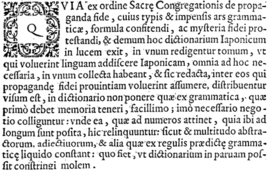E caudata

The e caudata ("tailed e", from Latin: cauda "tail") is a modified form of the letter E that can be graphically represented as E with ogonek (ę) but has a distinct history of usage. It was used in Latin from as early as the ninth century to represent the vowel also written ae or æ or in old Gaelic texts from the 13th century to represent an ea ligature.[1]
In Middle and Early Modern Irish manuscripts, and in unnormalised transcriptions of them, e caudata is used for e, ae and ea.
In Old Norse manuscripts, e caudata was used for both short and long versions of /æ/. In a few texts on Old Norse, it, like German ä, represents short /æ/, the result of i-mutation of Proto-Germanic */a/, and contrasts with e, which represents Proto-Germanic */e/. However, because these two vowels eventually merged to /e/ in the written varieties of Old Norse, they are commonly both written as e.
References
- ↑ "ea (ligature) • CODECS: Online Database and e-Resources for Celtic Studies". www.vanhamel.nl. Retrieved 2016-07-13.
| For a list of words relating to , see the Latin terms spelled with Ę category of words in Wiktionary, the free dictionary. |